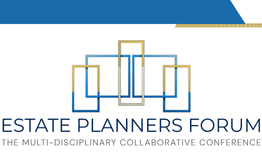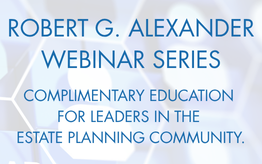July, 2010 Newsletter
Provided by Leimberg Information Services
See other issues.
Jeff Scroggin & the Future of Estate Planning
“No matter what happens to the federal estate tax, estate planning is anything but a diminishing industry. But here is the pivotal reality that all involved estate planners understand: estate planning is not most fundamentally about taxes – or even about the assets clients intend to pass. It is about dealing with death and incapacity. It is about dealing with clients trying to make the right decisions about how to deal with their own mortality, the consequences of their passing and how to leave a positive LEGACY.
This perspective starts with understanding that estate planning does not start with THINGS or the taxes imposed upon them. It starts with PEOPLE: Who clients were and are and who their families are and might become. In the last two decades the author has observed a significant re-orientation of both clients and advisors from believing that the protection and preservation of family assets (e.g., minimizing transfer taxes) is the most important goal of estate planning.
Increasingly, clients and planners recognize there is often a misplaced emphasis which focuses both the client and the planner on assets rather than family, on structure and technique over perspective, on tax savings in place of family need. When “protecting and preserving the family” becomes the beginning point of planning, clients first focus on how to leave a positive impact on their family. Both the client and the planner may be forced to deal with difficult family issues (e.g., treating the children as individuals with their own personalities and problems, not as equals), which both the client and the planner may have preferred to ignore - to the ultimate detriment of the client’s family.”
The estate tax debate has caused some soul-searching on the part of many professionals. Will there be an estate tax? Will I have a job? What will the landscape look like in the future? LISI has published a number of newsletters that have addressed this issue, and now, Jeff Scroggin provides members with his perspective.
John J. (“Jeff”) Scroggin has practiced as a business, tax and estate planning attorney in Atlanta for over 30 years. He holds a BSBA in accounting, J.D., and LL.M (Tax) from the University of Florida. Jeff serves as Founding Editor of the NAEPC Journal of Estate and Tax Planning and is a prior Co-Editor of Commerce Clearing House’s Journal of Practical Estate Planning. He has been a member of the Board of the National Association of Estate Planners and Councils since 2002. Mr. Scroggin is the author of over 200 published articles and columns. He has been named in Atlanta magazine as a 2009 and 2010 Georgia Super-Lawyer and as a 2009 and 2010 Five Star Wealth Advisor. Jeff is a nationally recognized speaker on estate, business and tax planning issues and has been quoted extensively, including in the Wall Street Journal (1999, 2004, 2005, 2006, 2007 & 2009), CNN Headline News, National Public Radio, Fortune Magazine, Forbes Magazine, Kiplinger’s, Money Magazine, Worth Magazine, Financial Advisor, National Underwriter, Bloomberg Wealth Management, Smart Money Magazine, Journal of Financial Services Professionals, Wall Street Magazine, BNA Estates Gifts & Trusts Journal, Financial Planning, the New York Times, the Chicago Tribune, the South China Post, the LA Times, the Miami Herald and Newsday. Jeff is owner of one of the largest private collections of tax memorabilia in the US.
Now, on to Jeff’s commentary:
EXECUTIVE SUMMARY:
Virtually all businesses are in a constant state of change. Businesses which fail to keep up or which hold to antiquated business models will ultimately die. The business of estate planning is no exception. Even though death and taxes may be the only two certainties of life, the manner in which clients and their advisors prepare for both is constantly evolving.
But, no matter what happens to the federal estate tax exemption, estate planning is anything but a diminishing industry. To the contrary, because of the factors discussed below (and other factors which the author has not thought of), estate planning, tax planning, tax compliance, fiduciary administration and all of their related areas will continue to grow at a rapid pace over the next few decades.
COMMENT:
Estate Taxes. The estate planning community is anxiously waiting to see what Congress may finally (or temporarily) do with the transfer tax rules. It is becoming increasingly probable that Congress will do nothing in 2010 and let the Economic Growth and Tax Relief Reconciliation Act of 2001 (EGTRRA) transfer tax rules sunset on January 1, 2011.
Or Congress might surprise many of us and adopt a permanent or temporary carryover of the 2009 rules. Or it could adopt a lower estate exemption – perhaps $2.0 million. Any changes in 2010 might or might not be retroactive. Or the 2010 changes might allow clients to elect to be under the 2009 rules or the 2010 rules.
If estate taxes are made retroactive, changes will be challenged all the way to the US Supreme Court (remember that a Texas oilman worth $9.0 billion died on March 28th) – causing even more uncertainty while we wait for the court’s verdict. Meanwhile, planners consider the 2010 planning opportunities if Congress fails to act. No wonder our clients are getting headaches when talking to us.
Based upon the recent dissolution of support in the Senate for estate tax reform, the author believes that there is a steadily decreasing chance that Congress will enact any transfer tax legislation in 2010. If correct, this will open up significant gift tax planning opportunities in 2010 and require that many clients reevaluate their estate plans before 2011.
If the EGTRRA transfer laws sunset on January 1, 2011 (a mere 7 months away), the amount of estate-tax-driven could explode as people suddenly pull their heads out of the sand and realize that the government may be taking up to 55% of their accumulated wealth if they die after 2010. New complexities will arise in those states which have decoupled from the federal estate credit for state estate taxes. The amount of estate-tax-driven work could dramatically increase.
Some commentators seem to believe that the passage of a high federal estate tax exemption (the general consensus seeming to be $3.5 million) is a forgone conclusion and that passage will significantly reduce the work of estate planning professionals. In order to examine this perspective, it is necessary to start by dividing federal estate-tax-driven clients into three primary categories, based upon the differences between the pre-EGTRRA rules and a $3.5 million estate exemption:
· Tier 1. The first tier consists of individuals or married couples who have never had much of an estate tax problem. This client has and expects to retain a taxable estate of less than $1.0 million. Whatever happens to the transfer tax code in 2010 or 2011 is of little consequence to this client – neither adding nor subtracting estate-tax-driven work for the estate planning community.
· Tier 2. The second tier are individuals or married couples with an estate over $1.0 million but less than $3.5 million. This second tier is in the crosshairs of the tension between EGTRRA’s sun-setting provisions and the possibility of higher exemptions. Assuming there are no estate tax changes in 2010, this tier will join the third tier group in trying to avoid the confiscatory federal estate tax that may return with a vengeance in 2011.
· Tier 3. The third tier are individuals or married couples with an estate over $3.5 million. Why $3.5 million and not $7.0 million for a married couple? Because this client still has to consider how to properly plan their estate to obtain the benefit of two estate exemptions – planning which is complicated by the existence of large retirement plans, blended families, mobility and other factors. The estate tax planning for this group will not go away any time in the foreseeable future. If the pre- EGTRRA rules return in 2011, estate tax planning work for clients in this tier could explode (i.e., because of the increased estate tax burden from lower exemptions and higher tax rates).
Effectively, the only group for whom federal estate-tax planning might diminish (if a large estate tax exemption were adopted) is the second tier. Since 2001, there has been a steady erosion of estate-tax-driven planning for the second tier of clients. Federal estate tax issues have not been the primary focus of this tier for years (at least since 2006 when the estate exemption went to $2.0 million or $4.0 million for a married couple), so most of the reduction in estate-tax-driven work has already occurred. Even though the estate-tax-driven work has diminished for this tier, much of that work has been replaced by clients refocusing on the other issues discussed in this newsletter.
Even if federal estate taxes are reduced for the middle tier, there are other tax considerations that will help offset those reductions in work, including: state death taxes will offset at least part of the reduction. The lack of uniformity in state death taxes will add complexity to estate plans.
As a result of the increased passage of wealth, the increasing use of trusts, the wide divergence on how the states tax trusts and estates and the mobility of Americans, a new area of tax planning is evolving: the state income taxation of grantors, trusts, and beneficiaries.
If a $3.5 million or larger exemption is enacted, the first two tiers will not focus as much on federal estate tax considerations. Their tax planning will refocus on strategies designed to reduce state estate taxes and state and federal income taxes. With the very real possibility of the top effective income tax rate exceeding 50% in the future, the income tax planning and basis planning aspects of estate planning will significantly increase.
What is Estate Planning? But here is the pivotal reality that all involved estate planners understand: estate planning is not most fundamentally about taxes – or even about the assets clients intend to pass. It is about dealing with death and incapacity. It is about dealing with clients trying to make the right decisions about how to deal with their own mortality, the consequences of their passing and how leave a positive LEGACY.
This perspective starts with understanding that estate planning does not start with THINGS or the taxes imposed upon them. It starts with PEOPLE: Who clients were and are and who their families are and might become. In the last two decades the author has observed a significant re-orientation of both clients and advisors from believing that the protection and preservation of family assets (e.g., minimizing transfer taxes) is the most important goal of estate planning.
Increasingly, clients and planners recognize there is often a misplaced emphasis which focuses both the client and the planner on assets rather than family, on structure and technique over perspective, on tax savings in place of family need. When “protecting and preserving the family” becomes the beginning point of planning, clients first focus on how to leave a positive impact on their family. Both the client and the planner may be forced to deal with difficult family issues (e.g., treating the children as individuals with their own personalities and problems, not as equals), which both the client and the planner may have preferred to ignore - to the ultimate detriment of the client’s family.
Many clients (no, not all of them) in all three federal estate tax tiers have increasingly begun to address the issue of “how much is too much” – or as Warren Buffet has said in a 1986 article in Fortune magazine: “[The perfect inheritance is] enough money so that they feel they could do anything, but not so much that they could do nothing.”
One element of this new perspective is that many clients have come to believe that their families may have more to fear from the negative impact of family wealth than they do from a confiscatory estate tax. Katherine Gibson of the Inheritance Project has noted: “The guilt and shame of inheriting wealth increases with each generation. The farther a generation is from the initial creation of wealth, the greater the guilt and shame become.” Clients want to provide for family, but are concerned about providing an unearned lavish lifestyle.
Interestingly, when you focus the planning on the client’s personal legacies, the personality of their heirs and similar non-tax issues, the discussion process and the drafting of documents can be more complex and the fees will be higher than when drafting standard form, tax-driven documents.
So do I stay in Estate Planning? But such seemingly philosophical perspectives may be of little comfort for that student just getting out of law school, or the laid off associate trying to decide if there is future in estate planning. Will estate planning diminish as a profession? Not remotely. Here are twelve of the many reasons that estate planning will remain a worthwhile business for decades to come, in no particular order – except the first one:
Mortality and Taxes Remain. First and Foremost: People will continue to die and taxes will continue to be imposed. As long as those two certainties remain, estate planners will be in demand.
Explosion of Wealth. Wealth in the United States has exploded – and while the recession has made a dent in it, there is still a lot of wealth spread across a lot of people. It is estimated that somewhere between $10-136 trillion will pass in the United States in the next 30-40 years. The lowest estimate came from a study by Avery & Rendall (Inheritance and Wealth, Presented to the Philanthropy Roundtable, November 1993), which estimated that $10.3 trillion would pass by the year 2040. The higher estimate came in 1999 from Boston College researchers Paul Schervish and John Havens and covers a larger period. They estimate that from 2000 to 2050 between $41 and 136 trillion will have passed.
Over $16 trillion were held in retirement plans and IRAs at the end of 2009 versus only $10.3 trillion in 1998. That growth will continue. The income tax, estate tax and dispositional aspects of such assets can be extremely complex, requiring meticulous planning.
According to Kiplinger’s, in 2001 roughly 50,000 small business owners retired, but by 2009 the number of retirees was expected to be approximately 750,000 - a fifteen-fold increase. Although the exit planning has been slowed by the impact of the recession and the inability of buyers to obtain financing, sales should accelerate once the economic recovery is in full swing and the credit markets have loosened. The tax, legal and liability issues surrounding exit planning for closely held business owners (e.g., the most tax efficient way to pass a family business to the next generation and anticipating conflicts over running a family business) will be an increasing source of estate planning work.
The Elder Boom. 79 million baby boomers are moving into retirement and old age. The elderly are increasing more than any other demographic group in the United States. Not only are the number of US citizens age 65 and older expanding rapidly, but people are generally living longer. According to the Census Bureau, the number of people over age 85 are increasing more than any other group. Increasingly, planning addresses the anticipated incapacity of the client (e.g., living wills, medical directives and powers of attorney). Issues of capacity for elderly clients will increasingly dominate their estate planning, particularly when changes are made to existing documents or new spouses enter the picture. This will result in attorneys spending more time to validate the capacity of their clients and more litigation as that capacity is challenged. Probate and guardianship work will continue to grow.
Charitable Planning. Estate planning at all tiers increasingly includes some form of charitable planned giving. During the 1990s wealth exploded in the United States, but clients tended to increase their charitable transfers more than their family inheritances. Perhaps as a consequence of the recent scandals in charities and the increasing “hands-on” management style of donors, clients increasingly want to retain in themselves and/or family the future direction of charitable transfers. Clients want to provide for charitable transfers which will leave a legacy for society and a legacy that will impact their heirs. Joel Breitstein noted the common bond between today’s donor and the 20th century philanthropists “...is the desire to transmit family values and social responsibility to successive generations...” This dual goal has resulted in not only a dramatic growth in charitable donations, but the development of “retained control” charitable giving approaches.
Handicapped Heirs. According to the US Census Bureau roughly 14.3 million Americans have significant mental disabilities in 2000. We have observed an increasing incidence of elderly clients trying to determine how to properly plan for the needs of their handicapped children when the parents pass. The estate planning process for handicapped clients can also be extremely complex and costly (e.g., guardianship of disabled adults).
Mobility of Clients. The Census Bureau reports that in 2009 roughly 4.6 million Americans moved across state lines. Roughly another 1.1 non-citizens migrated to the United States. According to the Census Bureau, the average American moves 11.7 times in a lifetime. In 2006 it was estimated that 6.0 million Americans were living abroad, up from 70,000 in 1966. This constant mobility will require the review and revision of existing client documents, examination of multi-jurisdictional legal and tax issues, and planning for the best domicile for clients to live and die in.
Marriage and Divorce. Too many clients have not heard the quote: “Marriage is often due to lack of judgment, divorce to lack of patience and remarriage to lack of memory.” Roughly 49% of all US marriages end in divorce. Divorce is often an ignored issue in estate planning. The high divorce and remarriage rate means that planners will deal with a constant stream of clients who have to deal with drafting new estate planning documents (e.g., time to get that ex-spouse off the medical directive). Documents will have to deal with the complexities of blended and dysfunctional families, and competing spousal views of how children and step-children should be treated. Conflicts among members of blended families will also create more estate litigation. Clients are increasingly struggling with how to fairly treat each member of the blended family (e.g., should the children of the less wealthy spouse participate in the inheritance of the assets of the wealthier spouse?). There also appears to be an increased incidence of “Orphaned Fathers” – fathers who have been abandoned by their disgruntled children and step-children.
The Failure to Plan. Many clients are not planning for their death or incapacity. Estimates are that 50-70% of Americans either have no estate planning documents or have out of date estate planning documents. While there may be no pre-planning work for these people, the lack of planning and the absence of well drafted documents will create tremendous probate (e.g., intestacy), tax and litigation work for estate planning advisors when the clients become incapacitated and/or die.
Conflict Minimization. Many clients have an abiding desire to establish structures which minimize the points of conflict and provide a mechanism to resolve family conflicts. Clients want to dispose of assets in a manner designed to minimize family conflict - leaving a legacy of relationships rather than a legacy of conflict. This is a growing part of the discussion with clients and a part of their documents (e.g., personal property disposition lists, looking at real or perceived conflicts of interest when appointing fiduciaries, passing the family business only to the children running the business).
Asset Protection. Clients are increasingly examining estate planning approaches which provide asset protection for their own benefit and the benefit of heirs. Many states are adopting statutes which make it easier for clients to restrict the claims of creditors. Asset protection will continue to be an increasing part of estate planning.
The Complexity of Trusts. Clients are increasingly using trusts for reasons which have little to do with federal estate tax avoidance. Trusts may be the most flexible planning tools available. The creativity is reflected in the various types of trusts which have evolved in the last few decades. Both the types of trusts and the sophistication of their terms are nothing like what we drafted even 30 years ago. Income tax planning opportunities using trusts will increasingly become part of the trust planning process (e.g., the use of discretionary spray trusts). Consider the following:
Forum shopping. Because of tax, asset protection and trust longevity issues, clients are increasing shopping for the optimum state to establish their trusts. This issue has been discussed in detail in the recent Leimberg Newsletters (LISI Estate Planning Newsletters #1596 (updated in #1600)).
Moving Trusts to Other Jurisdictions. As gaps have grown larger in the state laws and taxes rules governing trusts, a new legal specialty has begun to emerge: Advisors who deal with the tax, legal and fiduciary issues of moving trusts out of the state they were created in to states with more favorable rules. This trend should be expected to accelerate in the next few decades as states compete to encourage local trust services.
Spray Trusts. The new tax environment will encourage the allocation of income to lower-bracket taxpayers. The use of a trust discretionary “spray power” to allocate income among various family members (particularly those in lower tax brackets) will be an increasing part of the planning process.
Total Return Trusts. Investment models no longer fit into a pure fiduciary allocation between income and principal. States have been adopting statutes that permit existing trusts to be modified to become total return trusts. Although there is broad movement toward such trusts, the lack of uniformity between states has created a confused mosaic.
Spendthrift Trusts. As clients increasingly focus on asset protection and the potential for divorce for both themselves and their heirs, spendthrift trusts are increasingly becoming a part of estate planning. The use of discretionary trusts (in lieu of ascertainable standard trusts or mandatory distribution trusts) will also grow.
Self Funded Spendthrift Trusts. As the beginning of this year, 12 states have some form of a self-funded spendthrift trust or asset protection trust. This group of states will probably increase over time.
Dynasty Trusts. Estate planning process has increasingly focused on the need to preserve family capital across the generations, without losing it to confiscatory transfer taxes and wayward heirs. As a result, there has been an explosion of Dynasty Trusts in America. Banks and Trust Companies are increasingly focusing their marketing on Dynasty Trusts
Restrictive Trusts. While there are significant economic reasons to create a Dynasty Trust, clients need to thoroughly address the ultimate impact of such a trust on their families. As a result clients are increasingly adopting structures which limit the benefit family members may receive from a trust. Incentive trusts, safety net trusts, education trusts, and total return trusts can provide a mechanism for limiting the benefits that heirs will receive from the trust.
The Trustee’s Role. Although there have always been discretionary decisions by trustees, the nature of the discretionary decisions is changing. While this change is not universal, it is resulting in a substantial reorientation of trustee responsibility. Clients want to provide opportunities for families, without providing them an unearned lifestyle. Because it is impossible to draft for every contingency, clients are increasingly relying upon the subjective discretion of a trusted fiduciary to make the right decisions. It is a role that many institutional trustees would prefer to avoid.
Supplemental Needs Trusts. A non-marital trust instrument may provide that any benefits to beneficiaries supplement any governmental program or other sources available to the beneficiaries.
Qualified Plan Beneficiaries & Trusts. Because of the massive growth of assets held in retirement plans and the estate, income and dispositional complexities of passing such assets, trust planning for such assets has ballooned.
Exposure of Fiduciaries to Liability. The conflicting tax issues and diverse goals of beneficiaries may place fiduciaries in the untenable position of being forced into family conflicts or other exposures. As a result, planning for estates and trusts increasingly include ways to protect fiduciaries who are acting in good faith.
Delegating & Dividing Responsibility. Both trust instruments and state statues are increasingly providing for the delegation and allocation of fiduciary duties. For example, an institutional Co-Trustee can provide investment and administrative services while the family trustees make decisions on discretionary distributions.
Trustee Removal & Replacement. The process of removing and replacing fiduciaries is showing increasing sophistication, including the use of Trust Protectors (see below), processes for beneficiary involvement (e.g., supermajority approvals) and removal of institutional Co-Trustees by individual Co-Trustees.
Successor Trustees. Particularly where the trust is expected to have a long term existence (e.g., a Dynasty Trust), the trust agreement should provide a process by which successor trustees are chosen. Many potential Co-Trustees will not even be born when the trust is created.
Trust Protectors. The concept of special parties having power over trusts (e.g., to remove trustees and/or make certain modifications to the trust terms) is a relatively new concept which is growing in popularity.
Powers of Appointment. Both general and limited powers of appointment are being used to add flexibility to the estate plan. Powers of appointment provisions are becoming more sophisticated.
Domicile. Provisions in the trust instrument can allow the trustees (perhaps with beneficiary approval) to move the state of domicile of the trust (for example, if local tax laws change) and change the governing state law. For example, in the future other states may offer more attractive tax or trust management opportunities.
No-Contest Provisions. Documents may include provisions restricting the ability of beneficiaries to challenge the trust’s existence or operation. Although no-contest provisions are unenforceable in a few states, they can serve as useful impediment to an heir or creditor who wants to pierce the provisions of a trust.
Modifications. Provisions can be made in the trust instrument to allow for future non-dispositional revisions of the trust instrument. Thus, if there are changes in applicable laws or taxes 50 or 100 years from now, the trust may be modified to account for such changes.
Divorce. Any trust instrument should contemplate the impact of divorce or marriage. Such terms can add significant conflicts and complexities to planning documents (e.g., are the terms triggered at separation or legal divorce? What happens if reconciliation or remarriage occurs?).
Termination of the Trust. In the future, valid grounds for terminating a trust may emerge. In some cases the Trustees by unanimous agreement and possibly with the approval of a majority of the adult beneficiaries could terminate the trust. The critical issue in any termination (by the trustees or by the running of the Rule Against Perpetuities) is how the funds will be distributed at termination.
Changing Family Circumstances. New children, new grandchildren, new spouses (or ex-spouses), deceased parents, deceased spouses, deceased children, greater or lesser wealth, inheritances, new homes in new states…. Every family is constantly evolving and that evolution creates a constant stream of work for review of the old plans and adoption of new plans.
CONCLUSION:
If you are or intend to become an estate planning professional, you have chosen a worthwhile profession. Clients need the practical, insightful advice of seasoned professionals who understand not only the legal and tax complexities of estate planning – but perhaps even more, the personal (and often subliminal) undertones that underlay so much of what we do for our clients.
If you are an attorney, should you consider leaving the estate planning profession to become a divorce or corporate attorney? Dealing with the two great certainties of life will keep you employed and engaged in a constantly challenging and changing business – as long as you can make a difference in the lives of your clients. The day clients become just a number or an abused revenue source is the day your practice and employment will begin to dissolve.
HOPE THIS HELPS YOU HELP OTHERS MAKE A POSITIVE DIFFERENCE!
Jeff Scroggin
CITE AS:
LISI Estate Planning Newsletter #1657 (June 16, 2010) at http://www.leimbergservices.com Reproduction in Any Form or Forwarding to Any Person Prohibited – Without Express Permission.
All NAEPC-affiliated estate planning councils are eligible to receive a discounted subscription rate to the Leimberg LISI service. Please see more information about the offering. You may also contact your local council office / board member to find out whether they are offering the service as a member benefit.





